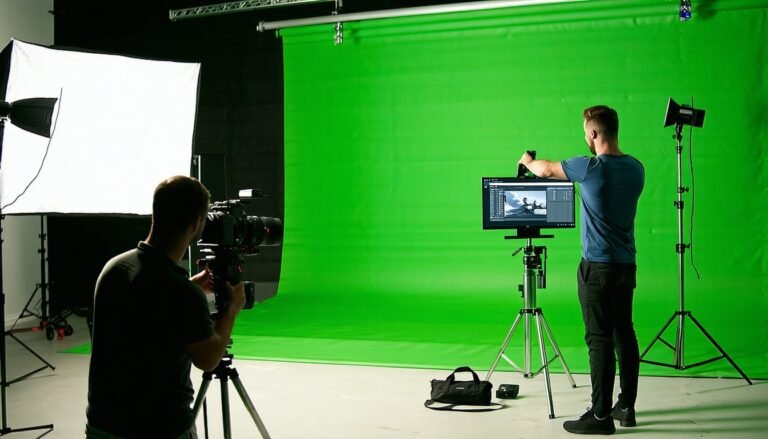If you’ve ever battled stubborn green fringes or funky color spills while compositing, yeah, I’ve been there too. Let’s delve into the professional keying techniques that will help you achieve flawless green screen extractions, so your viewers never suspect a thing. Whether you’re creating VFX for a short film, a YouTube series, or a feature-length project, these tips can help you turn even a tricky shoot into a polished final composite.
Start with good footage.
A clean key starts before you even launch your software. Quality footage is everything:
- Ensure your green screen is lit evenly, with no glaring hot spots or deep shadows. For more guidance, check out this green screen lighting setup.
- Keep your subject at a reasonable distance from the background so the green doesn’t bounce onto their skin or clothes.
- If your scene requires low light or your subject is wearing green attire, consider switching to a blue screen. It can preserve darker details and avoid color conflicts.
Choose the right tools.
When it’s time to pull your matte, your software is your best friend. Programs like After Effects and Nuke include dedicated keyers designed to handle green or blue screens. For a more in-depth approach, you can investigate the best green screen keying software to find tools that suit your style and workflow. If you’re using After Effects specifically, you may want to look into our guide on keying out green screen in After Effects.
Dial in your keyer’s settings.
Now comes the fun part. Every keyer, from Keylight to Primatte, offers sliders and knobs to refine your results. Pay close attention to:
- Screen color. Use the eyedropper to select the background hue precisely.
- Gain. Increasing gain removes more of the screen, but overdoing it can eat into your edges.
- Balance. This helps compensate for uneven background lighting and maintains natural tones.
- Clip black and white. These settings define which pixels are fully transparent and which are fully opaque.
Zoom in on your subject (especially hair and semi-transparent fabrics) to ensure you’re isolating your foreground without chopping off delicate edges.
Suppress unwanted spill
Even skilled lighting can’t always prevent subtle green reflections on hair, skin, or clothes. That’s where spill suppression swoops in to save the day. Most pro keyers let you tweak how aggressively you neutralize the background color:
- Use moderate settings so you’re not trading green halos for weird magenta or gray edges.
- Check skin tones after applying suppression. You don’t want a pale or “undead” look seeping into your subject.
- Remember that a minor manual color correction at the edges can work wonders.
Employ garbage mattes
Garbage mattes might not sound glamorous, but they’re a crucial part of professional keying techniques. By drawing a simple mask around your subject, you allow your keyer to ignore unnecessary parts of the frame. This focused approach can drastically reduce noise and shorten render times.
- Use a rough yet generous outline around your subject.
- Exclude cables, lighting stands, or vast empty stretches of screen.
- Animate the mask to follow your subject’s movements, keeping it tight but avoiding clipping of limbs or props.
Refine the final details
With your mat in decent shape, it’s time for the finishing moves:
- Inspect the alpha channel (or “screen matte view” in some keyers) for faint transparency or crunchy edges.
- Tweak the black and white clip settings or use a “soften” option to avoid harsh outlines.
- Neutralize any leftover green or blue tinges along the perimeter of fine details (like hair).
- Compare your keyed layer against the final background. If something looks off, zoom in and re-check your edge details.
Integrate seamlessly
A perfect key doesn’t live in a vacuum. The final composite should feel like your subject truly belongs in the new environment:
- Balance the color and lighting of your keyed layer to match the backdrop. Even the cleanest key looks fake if the highlights or color temperature clash.
- Add in subtle color grading, grain, or light spills that mirror the real-world conditions of your background.
- Consider a gentle blur to mimic depth of field, especially if your background plate has any out-of-focus regions.
If you want to take a deeper dive into composting strategy, our green screen compositing tutorial walks you step by step through blending the keyed subject into various environments.
Next steps
You now have the building blocks to achieve professional-grade chroma keys. Start by shooting high-quality footage, then lean on the right tools and proper settings to finesse the details. Don’t forget to celebrate the small wins along the way—every cleaned-up green halo deserves a big pat on the back. After all, keying might be one of the most crucial parts of your compositing workflow, but it doesn’t have to be a headache.
Keep experimenting, keep refining, and soon you’ll be the friendly neighborhood VFX artist that everyone counts on. Whether you’re working on micro-budget indie films or big commercial jobs, mastering these professional keying techniques will give you an edge. Now, grab that footage, open your favorite keyer, and create some magic!
FAQS – Frequently Asked Questions
What Are Professional Keying Techniques In Video Production?
Professional keying techniques involve advanced methods to remove backgrounds using chroma keying, ensuring clean edges, minimal spill, and realistic composites for visual effects.
Why Are Professional Keying Techniques Essential For Green Screen Editing?
Using professional keying techniques ensures precise edge detail and reduces color spill, making your green screen edits look seamless and natural.
How Do Professional Keying Techniques Handle Hair And Transparency?
Professional keying techniques use matte refinement and edge blending to retain details like hair strands and transparent fabrics, enhancing realism in compositing.
Which Software Supports The Best Professional Keying Techniques?
Tools like Adobe After Effects, Nuke, and DaVinci Resolve are popular for their advanced professional keying techniques and plugin support.
Can Professional Keying Techniques Remove Green Spill Completely?
Yes, using professional keying techniques like spill suppression and color correction effectively removes green spill for a cleaner result.
What Lighting Setup Supports Professional Keying Techniques?
A well-lit, evenly balanced green screen with separate lighting for the subject is ideal to achieve the best results from professional keying techniques.
Do Professional Keying Techniques Work With Blue Screens?
Absolutely. Professional keying techniques are effective for both green and blue screen footage, depending on the scene and subject colors.
What Are The Common Mistakes In Professional Keying Techniques?
Common mistakes include uneven lighting, poor color contrast, and ignoring edge refinement which reduce the effectiveness of professional keying techniques.
How Can I Learn Professional Keying Techniques?
You can learn professional keying techniques through online VFX courses, tutorials, and by practicing with compositing software like After Effects or Nuke.
What Role Do Alpha Mattes Play In Professional Keying Techniques?
Alpha mattes define transparent areas and are a critical part of professional keying techniques to isolate and refine the subject in post-production.
Are Plugins Necessary For Professional Keying Techniques?
Plugins like Keylight, Primatte Keyer, or Red Giant’s Keying Suite can greatly enhance professional keying techniques by offering more control and precision.
Can Beginners Use Professional Keying Techniques?
Yes, with proper training and the right tools, even beginners can start using professional keying techniques to improve their video projects.
How Do You Clean Up Noise Using Professional Keying Techniques?
Professional keying techniques include matte choker and denoise filters to eliminate noise around the subject for a smooth, professional finish.
Do Professional Keying Techniques Require 4K Footage?
While 4K footage offers more detail, professional keying techniques can work with HD footage if lighting and setup are optimal.
What’s The Difference Between Basic And Professional Keying Techniques?
Basic techniques remove backgrounds with minimal control, while professional keying techniques offer advanced matte editing, spill suppression, and edge refinement.
Are There AI Tools That Use Professional Keying Techniques?
Yes, modern AI tools now integrate professional keying techniques for automatic background removal and smart edge detection in real-time.
Can Professional Keying Techniques Be Used In Live Streaming?
Yes, professional keying techniques are now available in live streaming tools for real-time background replacement using OBS and similar software.
How Long Does It Take To Master Professional Keying Techniques?
Mastering professional keying techniques depends on practice, but a solid understanding can be developed within a few weeks of consistent learning.
Do All Video Editors Support Professional Keying Techniques?
No, only professional-level editors like After Effects, Nuke, and Fusion support full control for professional keying techniques.
What Is The Best Background Color For Professional Keying Techniques?
Green is commonly used, but blue is also effective depending on your subject. Both work well with professional keying techniques if lit properly.
Are Professional Keying Techniques Used In Films?
Yes, nearly every modern film that uses VFX relies on professional keying techniques for high-quality compositing and believable effects.













